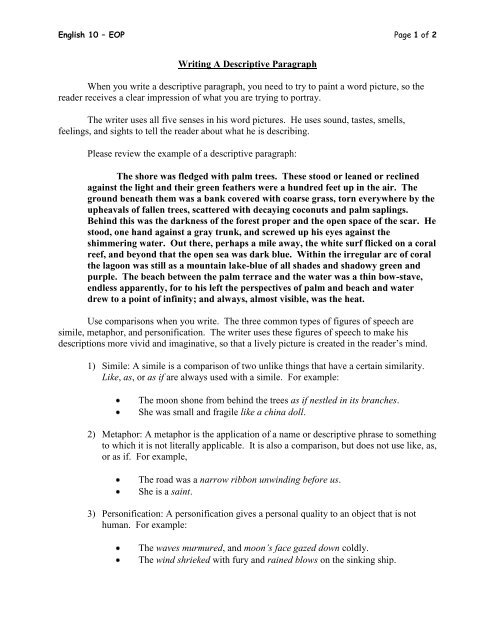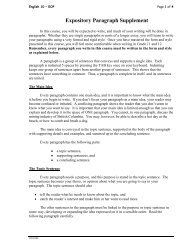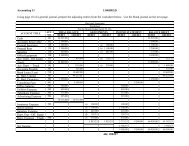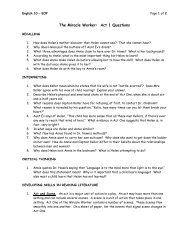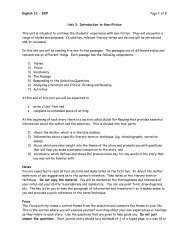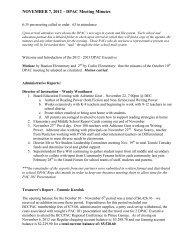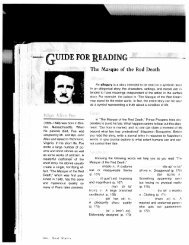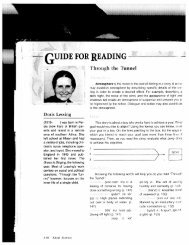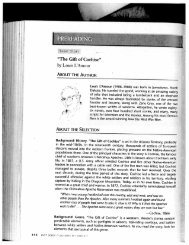Writing A Descriptive Paragraph.pdf
Writing A Descriptive Paragraph.pdf
Writing A Descriptive Paragraph.pdf
Create successful ePaper yourself
Turn your PDF publications into a flip-book with our unique Google optimized e-Paper software.
English 10 – EOP Page 1 of 2<br />
<strong>Writing</strong> A <strong>Descriptive</strong> <strong>Paragraph</strong><br />
When you write a descriptive paragraph, you need to try to paint a word picture, so the<br />
reader receives a clear impression of what you are trying to portray.<br />
The writer uses all five senses in his word pictures. He uses sound, tastes, smells,<br />
feelings, and sights to tell the reader about what he is describing.<br />
Please review the example of a descriptive paragraph:<br />
The shore was fledged with palm trees. These stood or leaned or reclined<br />
against the light and their green feathers were a hundred feet up in the air. The<br />
ground beneath them was a bank covered with coarse grass, torn everywhere by the<br />
upheavals of fallen trees, scattered with decaying coconuts and palm saplings.<br />
Behind this was the darkness of the forest proper and the open space of the scar. He<br />
stood, one hand against a gray trunk, and screwed up his eyes against the<br />
shimmering water. Out there, perhaps a mile away, the white surf flicked on a coral<br />
reef, and beyond that the open sea was dark blue. Within the irregular arc of coral<br />
the lagoon was still as a mountain lake-blue of all shades and shadowy green and<br />
purple. The beach between the palm terrace and the water was a thin bow-stave,<br />
endless apparently, for to his left the perspectives of palm and beach and water<br />
drew to a point of infinity; and always, almost visible, was the heat.<br />
Use comparisons when you write. The three common types of figures of speech are<br />
simile, metaphor, and personification. The writer uses these figures of speech to make his<br />
descriptions more vivid and imaginative, so that a lively picture is created in the reader’s mind.<br />
1) Simile: A simile is a comparison of two unlike things that have a certain similarity.<br />
Like, as, or as if are always used with a simile. For example:<br />
The moon shone from behind the trees as if nestled in its branches.<br />
She was small and fragile like a china doll.<br />
2) Metaphor: A metaphor is the application of a name or descriptive phrase to something<br />
to which it is not literally applicable. It is also a comparison, but does not use like, as,<br />
or as if. For example,<br />
The road was a narrow ribbon unwinding before us.<br />
She is a saint.<br />
3) Personification: A personification gives a personal quality to an object that is not<br />
human. For example:<br />
The waves murmured, and moon’s face gazed down coldly.<br />
The wind shrieked with fury and rained blows on the sinking ship.
English 10 – EOP Page 2 of 2<br />
Decide on a point of view. The point of view from the top of a mountain will be different<br />
from the point of view at the bottom of the mountain.<br />
Pick out the most interesting or important features of your scene. Don’t present too much<br />
detail, or you will confuse the reader.<br />
Arrange details in order of impression and of observation. Begin with the dominant<br />
feature of your scene. Describe it first then describe the scene around it in an orderly manner.<br />
For example, you could move from the foreground to the background, from the top to the<br />
bottom, from the centre to the circumference, or from right to left or left to right.<br />
You may use helpful phrases such as on the right, on the extreme right, just beyond,<br />
farther along, somewhat lower, in the distance, or just in front, to help to put the parts of the<br />
picture together for the reader.<br />
End the description with an important detail or an effective statement that relates to the<br />
central feeling or impression.


